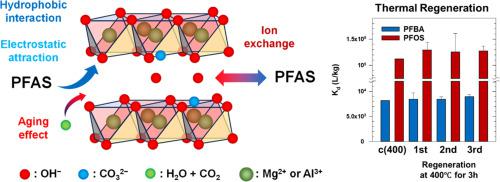当前位置:
X-MOL 学术
›
Water Res.
›
论文详情
Our official English website, www.x-mol.net, welcomes your feedback! (Note: you will need to create a separate account there.)
Removal of PFAS by hydrotalcite: Adsorption mechanisms, effect of adsorbent aging, and thermal regeneration
Water Research ( IF 11.4 ) Pub Date : 2024-06-11 , DOI: 10.1016/j.watres.2024.121925 Hak-Hyeon Kim , Paul G. Koster van Groos , Yuwei Zhao , Anh Le-Tuan Pham
Water Research ( IF 11.4 ) Pub Date : 2024-06-11 , DOI: 10.1016/j.watres.2024.121925 Hak-Hyeon Kim , Paul G. Koster van Groos , Yuwei Zhao , Anh Le-Tuan Pham

|
Layered double hydroxides (LDH) have been shown to be effective adsorbents, but their utility for the treatment of per- and polyfluoroalkyl substances (PFAS) in water has not been fully explored. In this study, the adsorption of 9 PFAS on hydrotalcite (HT), a type of LDH, was investigated using reaction solutions with environmentally relevant PFAS concentrations. The adsorption of individual PFAS by HT depended upon a range of factors, including the temperature used to pre-treat (i.e., calcine) the HT, aging conditions, and the presence of anions in the solution. HT calcined near 400 °C most effectively adsorbed PFAS, but its ability to adsorb PFAS was sensitive to storage conditions. The adsorption of CO and moisture from air, which likely resulted in the re-intercalation of CO into the interlayer regions of HT, was observed to reduce PFAS adsorption and may explain performance loss over time. The adsorption trend among 9 PFAS and the influence on this process by Cl, NO, SO, and CO indicated that adsorption occurred via a combination of ion exchange, electrostatic attraction, and hydrophobic interactions, although the relative importance of each mechanism deserves further investigation. During this study, we also demonstrated for the first time that HT can be thermally regenerated at 400 °C without affecting its ability to adsorb PFOS and PFBA. Overall, our results suggest that HT may serve as an effective alternative for PFAS treatment.
中文翻译:

水滑石去除 PFAS:吸附机制、吸附剂老化的影响和热再生
层状双氢氧化物(LDH)已被证明是有效的吸附剂,但其在处理水中全氟烷基物质和多氟烷基物质(PFAS)方面的效用尚未得到充分探索。在本研究中,使用具有环境相关 PFAS 浓度的反应溶液研究了水滑石 (HT)(一种 LDH)上 9 种 PFAS 的吸附。 HT 对单个 PFAS 的吸附取决于一系列因素,包括预处理(即煅烧)HT 所用的温度、老化条件以及溶液中阴离子的存在。在 400 °C 附近煅烧的 HT 最有效地吸附 PFAS,但其吸附 PFAS 的能力对储存条件敏感。空气中 CO 和水分的吸附可能导致 CO 重新嵌入 HT 的层间区域,观察到会减少 PFAS 吸附,并可能解释随着时间的推移性能损失。 9种PFAS之间的吸附趋势以及Cl、NO、SO和CO对此过程的影响表明吸附是通过离子交换、静电吸引和疏水相互作用的组合发生的,尽管每种机制的相对重要性值得进一步研究。在这项研究中,我们还首次证明了HT可以在400℃下热再生,而不影响其吸附PFOS和PFBA的能力。总的来说,我们的结果表明 HT 可以作为 PFAS 治疗的有效替代方案。
更新日期:2024-06-11
中文翻译:

水滑石去除 PFAS:吸附机制、吸附剂老化的影响和热再生
层状双氢氧化物(LDH)已被证明是有效的吸附剂,但其在处理水中全氟烷基物质和多氟烷基物质(PFAS)方面的效用尚未得到充分探索。在本研究中,使用具有环境相关 PFAS 浓度的反应溶液研究了水滑石 (HT)(一种 LDH)上 9 种 PFAS 的吸附。 HT 对单个 PFAS 的吸附取决于一系列因素,包括预处理(即煅烧)HT 所用的温度、老化条件以及溶液中阴离子的存在。在 400 °C 附近煅烧的 HT 最有效地吸附 PFAS,但其吸附 PFAS 的能力对储存条件敏感。空气中 CO 和水分的吸附可能导致 CO 重新嵌入 HT 的层间区域,观察到会减少 PFAS 吸附,并可能解释随着时间的推移性能损失。 9种PFAS之间的吸附趋势以及Cl、NO、SO和CO对此过程的影响表明吸附是通过离子交换、静电吸引和疏水相互作用的组合发生的,尽管每种机制的相对重要性值得进一步研究。在这项研究中,我们还首次证明了HT可以在400℃下热再生,而不影响其吸附PFOS和PFBA的能力。总的来说,我们的结果表明 HT 可以作为 PFAS 治疗的有效替代方案。






































 京公网安备 11010802027423号
京公网安备 11010802027423号